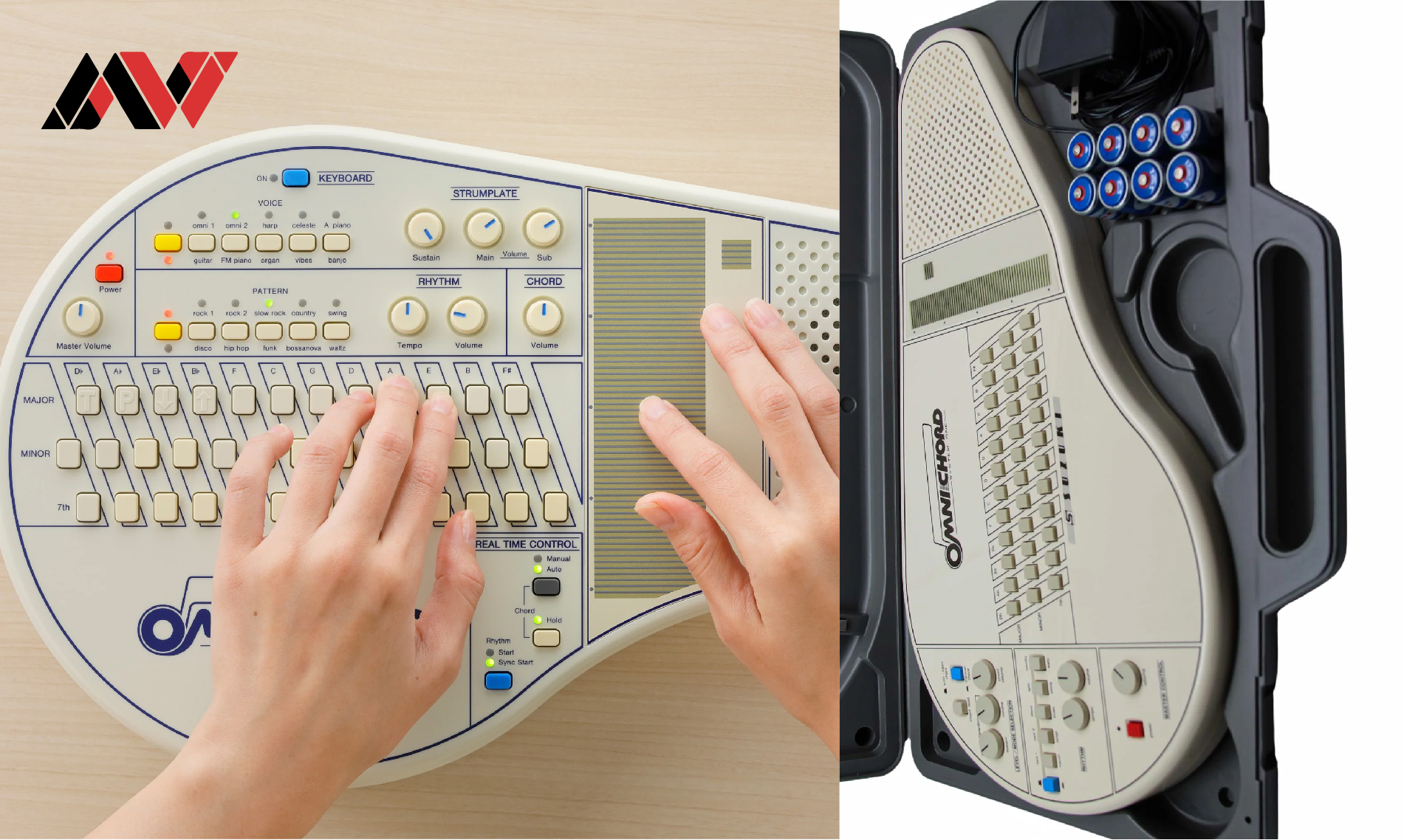The Suzuki Omnichord is a curious and fascinating musical instrument that has developed a cult following since its release. Originally created by the Suzuki Musical Instrument Corporation in the early 1980s, the Omnichord was designed to be an accessible and easy-to-play electronic instrument. Its quirky sound and unusual playing method have made it a favorite for both beginners and experienced musicians looking for something different. Despite not being as well-known as other electronic instruments, the Omnichord has left an enduring mark on music culture.
We’ll explore the history of the Suzuki Omnichord, its unique features, its cultural impact, and how it continues to inspire musicians today.
History of the Suzuki Omnichord
The Birth of a New Instrument
The Suzuki Omnichord was first introduced in 1981 by the Suzuki Corporation, a Japanese company best known for manufacturing musical instruments and educational products. The company initially designed the Omnichord as an electronic version of an autoharp, a stringed instrument with keys that automatically play chords. However, Suzuki’s vision was to create an instrument that could be used by anyone, regardless of their musical experience.
Early Models: OM-27 and Beyond
The first model of the Omnichord, the OM-27, featured 27 chord buttons, an electronic touchpad called the “SonicStrings” used to strum the chords, and a rhythm section with preset drum patterns. The OM-27 was designed to be simple enough for beginners to use but still offered enough flexibility for more experienced musicians. It quickly garnered attention for its unusual sound and ease of play.
Following the OM-27, Suzuki released several more models, such as the OM-36 and OM-84, each with incremental improvements in sound quality, chord options, and rhythmic capabilities. By the late 1980s, the Omnichord had become a staple in homes, music classrooms, and even recording studios.
Key Features of the Suzuki Omnichord
SonicStrings: The Heart of the Omnichord
One of the most distinctive features of the Omnichord is its “SonicStrings” touchpad. Unlike traditional stringed instruments, where the musician plucks or strums actual strings, the Omnichord uses a touch-sensitive pad that simulates the act of strumming. This pad allows the user to create smooth, flowing sounds by running their fingers across it, producing a series of electronic notes that correspond to the selected chord.
The SonicStrings pad provides the player with a wide range of expressive possibilities. By varying the pressure and speed of the finger strokes, players can achieve different effects, from gentle glissandos to sharp staccatos. This feature, combined with the preset chord buttons, makes the Omnichord an accessible instrument for anyone who wants to create music quickly and easily.
Chord Buttons and Preset Rhythms
The chord buttons are another signature feature of the Omnichord. These buttons allow players to instantly produce major, minor, and seventh chords with the press of a button. The Omnichord typically includes a wide array of preset rhythms, including waltz, rock, samba, and disco, making it a versatile instrument for different musical styles.
The rhythmic section gives the Omnichord a built-in accompaniment, so even a solo player can create a rich, full sound. This has made the Omnichord popular in both live performances and recording sessions.
Portability and Durability
Another appealing feature of the Omnichord is its portability. Lightweight and relatively compact, the instrument is easy to transport and use in various settings, from home studios to live performances. Many models of the Omnichord run on batteries, adding to their portability and making them an excellent choice for street performers or musicians on the go.
The Omnichord’s Unique Sound
Quirky Yet Versatile
The Omnichord’s sound is often described as quirky, ethereal, and somewhat retro-futuristic. Its combination of electronic strumming, synthesized tones, and preset rhythms creates a sound that is unmistakable and distinctive. The instrument is capable of producing everything from gentle, ambient music to upbeat, pop-inspired tunes.
Many musicians are drawn to the Omnichord because of its lo-fi, almost nostalgic sound. While it may lack the complex harmonics of acoustic instruments or the depth of modern synthesizers, its simplicity is part of its charm. The Omnichord’s sound is instantly recognizable and has been embraced by various music genres, including indie rock, folk, and experimental music.
Famous Omnichord Users
Despite its niche status, the Omnichord has been used by a surprising number of high-profile artists. One of its most famous advocates is singer-songwriter Björk, who incorporated the Omnichord’s distinctive sound into several of her tracks. Artists like Damon Albarn of Blur and Gorillaz, as well as indie bands like The Magnetic Fields and The Postal Service, have also experimented with the instrument in their music.
The Omnichord’s presence in contemporary music has helped it maintain a loyal fanbase even decades after its initial release. Its ability to bridge the gap between electronic and acoustic music has made it a favorite among musicians looking for something unique.
Cultural Impact of the Suzuki Omnichord
A Cult Following
While the Omnichord was never a mainstream instrument, it has developed a devoted cult following over the years. Vintage models of the Omnichord are highly sought after by collectors and musicians alike, with some models becoming rare and expensive. The instrument’s charming design, quirky sound, and nostalgic appeal have made it a favorite among retro enthusiasts and those interested in experimental music.
Revival of Interest in Electronic Instruments
In recent years, there has been a resurgence of interest in vintage electronic instruments, and the Omnichord is no exception. As more musicians explore the possibilities of combining analog and digital sounds, the Omnichord has seen a renewed popularity. Its simplistic design, coupled with its distinctive sound, makes it an attractive option for musicians looking to add a unique texture to their music.
Additionally, modern technologies have allowed for the creation of digital emulations of the Omnichord, meaning that the sound of this iconic instrument can now be recreated using software synthesizers and mobile apps.
The Evolution of the Omnichord: Qchord
The Successor: Suzuki Qchord
In the 2000s, Suzuki introduced the Qchord, the spiritual successor to the Omnichord. While the Qchord retained many of the features that made the Omnichord popular, including the strum plate and chord buttons, it offered more advanced sound synthesis and greater versatility. The Qchord expanded the possibilities of sound creation, with more instrument voices and rhythms to choose from.
The Qchord also features MIDI output, allowing it to be integrated into modern digital music setups. This has made the Qchord an appealing option for musicians who want the charm of the Omnichord with the flexibility of modern digital instruments.
Legacy of the Omnichord
The Omnichord’s legacy lives on through its enduring presence in music. It remains a beloved instrument for musicians seeking a unique sound, and its quirky nature continues to inspire new generations of artists. Whether through the original models or modern digital versions, the Omnichord’s influence is still felt in today’s music landscape.
Conclusion
The Suzuki Omnichord is more than just a quirky, retro instrument; it represents a unique chapter in the history of electronic music. Its accessible design, distinctive sound, and versatility have made it a beloved instrument among musicians and collectors alike. Though it may not be as famous as the synthesizer or electric guitar, the Omnichord has carved out a special place in music history. With its cult following and revival in the digital age, the Omnichord continues to inspire musicians and music lovers around the world.
Read more: A Complete Guide to Logitech Unifying Software Download: Simplifying Device Connectivity




